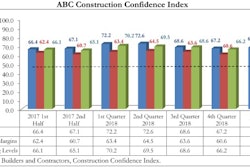
Maryland’s quality of life and economic development is being hampered by high levels of traffic congestion and reduced accessibility. However, it is benefitting from a statewide program to improve accessibility, and Governor Hogan has proposed a comprehensive set of transportation improvements designed to improve mobility, according to a new report released today by TRIP, a Washington, DC based national transportation research nonprofit.
According to the TRIP report, “Keeping Maryland Mobile: Accomplishments and Challenges in Improving Accessibility in Maryland to Support Quality of Life and a Strong Economy,” the state’s roads carry the highest traffic volume in the nation and commute lengths are the second longest in the U.S. Traffic congestion costs the state’s residents and businesses billions of dollars each year and severely constrains the number of jobs accessible to residents.
The Maryland Department of Transportation State Highway Administration (MDOT SHA) is implementing a plan to relieve congestion and enhance reliability. Governor Hogan has recommended a $17.8 billion multimodal congestion relief plan designed to accommodate growth and improve economic development.
One-Third of America's Urban Roadways in Poor Condition
Lost Time, Dollars and Jobs
Maryland’s major urban highways and roads carried the highest average daily traffic per lane mile in the nation in 2017. The average daily commute for the state’s residents was 32.7 minutes, the second longest average commute in the nation, behind only New York at 33 minutes.
The average driver in the Washington, DC area loses 87 hours to congestion each year at an annual cost of $2,007 per driver in lost time and wasted fuel. In the Baltimore area, the average driver loses 50 hours to congestion annually at a cost of $1,220 annually in lost time and wasted fuel. Congestion on the state’s highways, freeways and major arterial roads costs the pubic $3.4 billion annually in the value of lost time and wasted fuel.
Traffic congestion also impacts the number of jobs available to residents. Of the approximately 1.9 million jobs accessible within a one-hour drive to residents of the Baltimore metro area in 2017, only 30 percent were accessible within a 30-minute drive. And of the approximately 2.6 million jobs accessible within a one-hour drive to residents of the Washington, DC metro area, only 24% were accessible within a 30-minute drive. In 2017, the number of jobs accessible within a 40-minute drive in the Baltimore and Washington, DC metro areas during peak commuting hours was reduced by 38% and 47%, respectively, as a result of traffic congestion
The TRIP report also identified the most congested portions of Maryland highways and arterial (non-freeway) roadways during weekday AM and PM peak travel hours. The chart below details the 10 most congested highways and arterial roadways during peak AM and PM travel hours. A full list of the most congested segments is included in the report.

“The TRIP report outlines exactly why the Traffic Relief Plan is critical to address the congestion Marylanders deal with every day,” said MDOT Secretary Pete K. Rahn.
Impacts on Freight Movement
Freight shipments in Maryland, which are primarily carried by trucks, are expected to increase significantly through 2040 due to population and economic growth, and changes in business, retail and consumer models, which rely on a faster and more responsive supply chain. The efficiency of freight movement in Maryland is threatened by traffic congestion, which reduces the reliability of goods movement to and from destinations in the state and through the state.
The chart below ranks the five highway segments in Maryland that provide the worst travel reliability for commercial trucks as a result of traffic congestion. A full list is included in the report.

MDOT SHA congestion relief programs – which include an incident management program, additional park and ride spaces, HOV lanes, new sidewalks and bike lanes, and improvements to at-grade rail crossings and major intersections – were estimated in 2016 to save approximately $1.6 billion in reduced delays, fuel consumption and emissions. In addition to the efforts already underway, Governor Hogan has recommended a $17.8 billion multimodal congestion relief plan that includes the following:
- widening approximately 70 miles of Interstates via funding provided through a public-private partnership,
- completion of the Purple Line from the Bethesda Metro Station to the New Carrollton Metro Station,
- and a statewide expansion of the smart traffic signal program.
“It is critical that Maryland have a robust transportation plan capable of improving mobility and accessibility, which is vital to the state’s economic health and quality of life,” said Will Wilkins, TRIP’s executive director. “While recent state efforts to ease congestion and improve the reliability of Maryland’s transportation system have been helpful, more work still needs to be done. Congress can help by fixing the federal Highway Trust Fund and passing major infrastructure legislation.”
Report: Michigan Transportation Improvements Underway But More Funding Needed

















![Fcp Racatac Chair 10893876[1]](https://img.forconstructionpros.com/mindful/acbm/workspaces/default/uploads/2025/10/fcp-racatac-chair-108938761.10l0At5WXv.png?ar=16%3A9&auto=format%2Ccompress&bg=fff&fill-color=fff&fit=fill&h=135&q=70&w=240)

